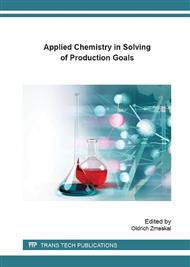[1]
R. Dvořák, et al. Incineration and gasification technologies completed with up-to-date off-gas cleaning system for meeting environmental limits, In Clean technologies and environmental policy. 11 (2009) 95–105.
DOI: 10.1007/s10098-008-0170-7
Google Scholar
[2]
R. Idem P. Tontiwachwuthikul, Preface for the Special Issue on the Capture of Carbon Dioxide From Industrial Sources: Technological Developments and Future Opportunities, Industrial & Engineering Chemistry Research. 45 (2006) 2413.
DOI: 10.1021/ie0680019
Google Scholar
[3]
K. H. Javed, T. Mahmud, E. Purba, The CO2 capture performance of a high-intensity vertex spray scrubber, Chemical Engineering journal. 162 (2010) 448–456.
DOI: 10.1016/j.cej.2010.03.038
Google Scholar
[4]
CH. Pao-Chi, et al. Scrubbing of CO2 greenhouse gases, accompanied by precipitation in a continuous bubble-column scrubber, Industrial & Engineering Chemistry Research. 47 (2006) 2522–2530.
DOI: 10.1021/ie070324x.s001
Google Scholar
[5]
M. T. Ho, G. Leamon, G. W. Allison, D. E. Wiley, Economics of CO2 and mixed gas geosequestration of flue gas using gas separation membranes, Industrial & Engineering Chemistry Research. 8 (2006) 2546–2552.
DOI: 10.1021/ie050549c
Google Scholar
[6]
H. Th. J. Reijers, et al. Hydrotalcite as CO2 sorbent for sorption-enhanced steam reforming of methane. Industrial & Engineering Chemistry Research. 8 (2006) 2522–2530.
DOI: 10.1021/ie050563p
Google Scholar
[7]
P. Pitter, Hydrochemie, fourth revised ed., VŠCHT, Prague, (2009).
Google Scholar
[8]
R. B. Bird, W. E. Stewart, E. N. Lightfoot, Transport Phenomena, Revised 2nd Edition, John Wiley and Sons, New York, (2002).
Google Scholar
[9]
CH. Geankoplis, Transport Processes and Separation Process Principles (Includes Unit Operations), fourth edition, Prentice Hall Press, New Jersey, (2003).
Google Scholar
[10]
P. A. Johnson, A. L. Babb, Liquid Diffusion Of Non-Electrolytes, Chemical Reviews. 56 (1956) 387–453.
DOI: 10.1021/cr50009a001
Google Scholar
[11]
E. L. McCabe, J. C. Smith, P. Harriott, Unit operations of Chemical Ingineering, fifth edition, Chemical Engineering Series, McGraw-Hill, USA, (1993).
Google Scholar
[12]
W. K. Lewis, W. G. Whitman, Principles of Gas Absorption, Industrial \& Engineering Chemistry. 16 (1924) 1215–1220.
DOI: 10.1021/ie50180a002
Google Scholar
[13]
R. Higbie, The rate of absorption of a pure gas into a still liquid during short periods of exposure, Transactions of the American Institute of Chemical Engineers. 31 (1935) 365–389.
Google Scholar
[14]
P. V. Danckwerts, Significance of Liquid-Film Coefficients in Gas Absorption, Industrial & Engineering Chemistry. 43 (1951) 1460–1467.
DOI: 10.1021/ie50498a055
Google Scholar
[15]
H. L. Toor, J. M. Marchello, Film-penetration model for mass and heat transfer, American Institute of Chemical Engineers journal. 4 (1958) 97–101.
DOI: 10.1002/aic.690040118
Google Scholar
[16]
J. C. Lamont, D. S. Scott, An eddy cell model of mass transfer into the surface of a turbulent liquid, American Institute of Chemical Engineers journal. 16 (1970) 513–519.
DOI: 10.1002/aic.690160403
Google Scholar
[17]
P. D. Vaidya, E. Y. Kenig, Gas-Liquid kinetics: A review of determination methods, Chemical Engineering Communications. 194 (2007) 1543–1565.
DOI: 10.1080/00986440701518314
Google Scholar


